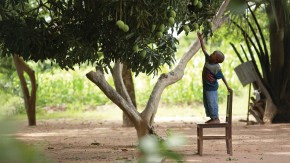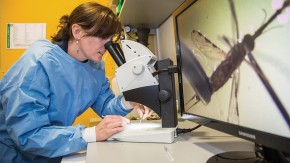James Baker discusses vaccine biology with his team in the lab.

James Baker in his lab at the University of Michigan.
James R. Baker, University of Michigan, United States
Imagine vaccines largely composed of soybean oil, ethanol, water and soap that can be given as nose drops instead of through syringes. And, imagine the vaccines can be stored at room temperature, eliminating the need for refrigeration that can add significant costs to large-scale immunization programs in the developing world.
That's what James Baker has imagined. In 2005 Baker, an immunologist and vaccine researcher at the University of Michigan Medical School, won a $6.9 million grant from the Bill & Melinda Gates Foundation's Grand Challenges in Global Health program. The goal was to develop vaccines that can be administered needle-free. Vaccines that require syringe and needle administration are associated with increased risk of infection through inappropriate re-use of needles, especially in settings in which resources (including syringes and needles) are limited. A nasal route also might expand access to vaccines by eliminating the need for health personnel trained in needle injections. Baker's vaccines also addressed another need initially identified by the foundation to create vaccines that can be stored and shipped without requiring a so-called cold chain supply system. Vaccines that are easier to use and less costly to distribute would meet a major goal of the Gates Foundation: widening access to international immunization programs against preventable childhood illnesses in remote regions in Africa, Asia and Latin America.
"I pride myself on doing things that are reproducible and rational," says Baker, sitting in his office at the university on a snowy winter day overlooking the campus at Ann Arbor, Michigan. "The work we had already completed prior to getting the grant convinced me we could create a simpler way to administer vaccines."
Ten years after receiving the Gates grant, Baker and his university lab, as well as labs at nearby NanoBio Corp., a company Baker formed to help develop the technology, have developed these new types of vaccines, at least in experimental versions. In tests on laboratory mice, intranasal vaccines created by the Baker labs have produced protective immune responses against hepatitis B, anthrax, and certain influenza strains.[1],[2],[3] The U.S. government has awarded NanoBio a $10 million grant to determine if the vaccine technology can be used against a pandemic flu outbreak. Large amounts of the product could conceivably be warehoused without the need for refrigeration, allowing for long-term and low-cost storage at sites around the world.
One of the experimental vaccines to emerge as a result of the Grand Challenges in Global Health funding may someday protect against respiratory syncytial virus (RSV),[4] a pulmonary infection that can be especially dangerous to young children and the very elderly. An RSV vaccine, if proven safe and effective in clinical trials, would provide a significant public health advance. Currently, there is no commercially available vaccine to prevent RSV, a major cause of hospitalizations and deaths each year for children under age one, especially among those living in poor nations. To date, however, no efficacy trials of Baker's product have been planned or funded as public health officials, the Gates Foundation and manufacturers debate whether Baker's new approach merits the high cost of testing or would be as widely used as initially expected.
Even if Baker's nasal vaccines don't become widely used against infectious diseases, they still represent an innovative approach created as a result of the Grand Challenges in Global Health grant. Baker's technology is not a vaccine itself, but rather an adjuvant, a material with which researchers can mix immune priming agents called antigens to boost the resulting immune response. These antigens are pathogen-associated molecules that can alert the body's immune system to spur the release of antibodies and infection-fighting cells. By combining various oils, water and detergent-like soapy substances in a high-energy industrial blender, Baker's labs have created an emulsion, a mixture of substances, such as fats and water that don't readily combine, akin to, say, a salad vinaigrette. The emulsions produced by Baker and his colleagues are composed of liquid droplets between 200 and 300 nanometers in size. (A nanometer is one billionth of a meter.) In experiments conducted at his lab at the university and at NanoBio, Baker and his colleagues have produced immune responses consistent with those needed for protection by combining their so-called nanoemulsion adjuvants with antigens from various strains of flu and hepatitis B viruses and RSV.
While a prototype flu vaccine based on the technology was shown to be safe in clinical trials,[3] the other vaccines have yet to be tested for safety in humans. Federal contracts support upcoming trials for anthrax and pandemic flu vaccines, Baker says. In 2011, the pharmaceutical company Merck & Co. signed a collaboration agreement with NanoBio to develop the RSV vaccine. The companies have said they plan to combine an RSV antigen developed by Merck researchers with NanoBio's nanoemulsion technology, called NanoStat, to create an effective intranasal vaccine that can last weeks at room temperatures.
If an effective RSV vaccine does ultimately emerge from the human studies, NanoBio, which licensed the technology from the University of Michigan, has agreed that a resulting product will be made available to nations in the developing world at a price that is sustainable and that fosters broad adoption. The agreement is the result of a requirement made by the Grand Challenges in Global Health program with all grantees that while commercial products arising from the research can be marketed at competitive prices in rich nations, they should be affordable to public health programs in poor nations.
Baker arrived at the University of Michigan in 1989 after a 12-year stint as an army doctor. During that time he received post-graduate training as an immunologist at the National Institute of Allergy and Infectious Diseases and worked on vaccine development at Walter Reed Army Medical Center. In the mid-1990s, he began working with emulsions, similar to the blends of oils, water and soap-like chemicals used in making facial creams. As these blends produced particles small enough to enter epithelial, or skin cells, Baker began testing whether an oil-water-detergent emulsion could serve as an adjuvant to administer vaccines, such as one against the flu, that would enter the body through the mucosal, or epithelial lining, of the nose.
In 1996, Baker received an $11 million grant from the U.S. Department of Defense to help develop a product to protect or treat soldiers who might be exposed to anthrax, a disease caused by a potentially lethal spore-forming bacterium. The Army was concerned that a rogue nation or terrorists might develop anthrax as a weapon. It turned out that one of the emulsions he had been working on had an anti-infective activity. By itself, and without the addition of an antigen, the chemical blend inactivated spores, the substances that can float in the air and produce a respiratory infection, suggesting the product might be used to decontaminate surfaces or even be rubbed on skin. "The emulsion had this surprising anti-infective activity," Baker says. "It was an accidental finding." Further tests showed that when administered to the nasal mucosa the emulsion alone spurred the body to produce a measurable immune response to anthrax spores. To Baker, this meant the emulsion might be a suitable adjuvant to provide immunity to respiratory viruses, such as the flu, that invade the body through epithelial cells in the mucosal linings of the nose or within the lungs. Instead of developing an anthrax product, Baker began testing the idea as a way to protect people against respiratory infections.
In late 2000, Baker's lab at University of Michigan published their first report showing that a nanoemulsion protected lab mice treated intranasally from the respiratory infection.[5] A later study combined the emulsion, an oil and water blend stabilized with a surfactant, a detergent-like compound, with inactivated flu virus, which triggered the release of antibodies against the virus as well as chemokines, protein products of immune cells that alert other immune system agents to the presence of a specific infectious agent. Animals vaccinated with the influenza nanoemulsion mixture were "completely protected against infection," while those vaccinated with either the inactivated virus or the nanoemulsion alone developed viral pneumonitis and died a week after being exposed to the flu, according to the report.[6]
"We weren't completely sure why at the time, but the evidence showed that the nanoemulsion was a terrific adjuvant," says Baker. The researchers suggested that the nanometer-sized droplets slipped easily into nasal epithelial cells. From there, the researchers speculated, the antigen inside the nanoemulsion particles was recognized by dendritic cells that line mucosal tissue. The dendritic cells in turn likely present the antigen to the immune system.

In 2004, Baker learned about the Grand Challenges in Global Health grants seeking projects to develop needle-free vaccines. "I thought that's what we had so let's see if we can make some important vaccines," Baker recalls. The Grand Challenges in Global Health staff suggested Baker first try to create an intranasal hepatitis B vaccine as proof-of-concept for the nanoemulsion technology. As there already was an existing vaccine against hepatitis B without an adjuvant and administered by injection, Baker could determine if his vaccine produced a similar immune response. Baker believed his approach might also address the costly need for a "cold chain" supply system, the specific objective of one of the other Grand Challenges. By 2007, the Baker labs had created a nose-drop vaccine based on a mixture of a hepatitis B surface antigen, soybean oil, alcohol, water and detergents emulsified into droplets less than 400 nanometers in diameter. In a study of lab mice, the vaccine generated antibodies at about the same level produced by an existing hepatitis B injectable product. The study showed the vaccine retained its effectiveness for six months when stored at 25°C and for six weeks at 40°C, much longer than the existing version of the vaccine.[1]
At the time the project began, the Grand Challenges in Global Health staff believed a needle-free version of a hepatitis B vaccine would be a good target for a proof-of-principle project, says Steven Buchsbaum, who leads the Gates Foundation family of Grand Challenges grant programs. But by the time Baker's labs had developed the hepatitis B vaccine the Grand Challenges staff realized commercial interest in a needle-free product against the virus was limited. "In hindsight we realize that a needlefree and thermostable hepatitis B vaccine might cost more to test and develop than was warranted by the improvements it would yield over the current technology," Buchsbaum says.
By this time, however, NanoBio had begun research into an intranasal RSV product as no vaccine against the virus existed at that time. In a study in lab mice in 2011, the vaccine spurred antibodies and other immune agents that enhanced immunity to RSV.[4] Subsequent work has analyzed the product in primates, and the next step, says Baker, is to test the vaccine in people.
In March 2014, Merck acquired the commercial rights to develop a nanoemulsion-based RSV vaccine using Merck's proprietary antigen. The pharmaceutical company also licensed the rights to use NanoBio’s technology in developing an intranasal flu vaccine. In October of the same year, Baker's team at the university and NanoBio presented a report at a scientific meeting showing that an intranasal vaccine against genital herpes provided protection against infection in guinea pigs. At present, there is no vaccine against the herpes virus. The Baker technology is also still being pursued under the government grant for uses against anthrax, whooping cough and herpes.
THE SCIENCE:
Developing and characterizing a mucosal adjuvant for intranasal administration
Mucosal vaccines can provide humeral and cell-mediated immunity at both mucosal and systemic sites in the body.[7] This is mainly due to specialized dendritic cells (DCs) residing in the mucosal tissues, which drive the activation and expansion of effector B and T cells that localize to mucosal tissues. As many pathogens access the body via mucus membranes, mucosal vaccines may provide an extra layer of immune protection. However, protein subunit or inactivated antigen vaccines administered through the gut mucosa are mostly poorly immunogenic and may activate regulatory T cells triggering immune tolerance, which protects against damaging inflammatory reactions to non-harmful antigens.
Baker and colleagues have developed one of the first effective mucosal adjuvants for intranasal administration. Their non-toxic, <400nm nanoemulsion of soybean oil, non-ionic and cationic surfactants, and ethanol[8] induces humeral and T helper (Th)-1- and Th-17-polarized immune responses against influenza, anthrax, HIV, smallpox, hepatitis B and respiratory syncytial virus [RSV) in small animal models.[1], [2], [4], [6], [9], [10] (Th-17 responses are thought to be critical for mucosal immunity). The molecular mechanisms underlying the adjuvant function of this simple nanoemulsion are still unclear, but they have shown that it increases antigen uptake and trafficking by epithelial cells and DCs.[11], [12] And even though it lacks innate receptor ligands, it activates the immune system by toll like receptor (TLR)-dependent and independent mechanisms including upregulating expression of the central immune system transcription factor NF-κB and various cytokines, and promoting DC maturation.[13] These insights will help in the rational design of more effective mucosal vaccines.
REFERENCES:
[1] [a],[b],[c] Makidon PE, Bielinska AU, Nigavekar SS, Janczak KW, Knowlton J, Scott AJ, Mank N, Cao Z, Rathinavelu S, Beer MR, Wilkinson JE, Blanco LP, Landers JJ, Baker JR Jr. Pre-clinical evaluation of a novel nanoemulsion-based hepatitis B mucosal vaccine. PLoS One 13, e2954 (2008).
[2] [a],[b] Bielinska AU, Janczak KW, Landers JJ, Makidon P, Sower LE, Peterson JW, Baker JR Jr. Mucosal immunization with a novel nanoemulsionbased recombinant anthrax protective antigen vaccine protects against Bacillus anthracis spore challenge. Infect Immun. 75, 4020-9 (2007).
[3] [a],[b] Stanberry LR, Simon JK, Johnson C, Robinson PL, Morry J, Flack MR, Gracon S, Myc A, Hamouda T, Baker JR Jr. Safety and immunogenicity of a novel nanoemulsion mucosal adjuvant W805EC combined with approved seasonal influenza antigens. Vaccine 30, 307-16 (2012).
[4] [a],[b],[c] Lindell DM, Morris SB, White MP, Kallal LE, Lundy PK, Hamouda T, Baker JR Jr, Lukacs NW. A novel inactivated intranasal respiratory syncytial virus vaccine promotes viral clearance without Th2 associated vaccine-enhanced disease. PLoS One 6, e21823 (2011).
[5] Donovan BW, Reuter JD, Cao Z, Myc A, Johnson KJ, Baker JR Jr. Prevention of murine Influenza A virus pneumonitis by surfactant nanoemulsion, Antiviral Chemistry and Chemotherapy 11, 41-49 (2000).
[6] [a],[b] Myc A, Kukowska-Latallo JF, Bielinska AU, Cao P, Myc PP, Janczak K, Sturm TR, Grabinski MS, Landers JJ, Young KS, Chang J, Hamouda T, Olszewski MA, Baker JR Jr. Development of immune response that protects mice from viral pneumonitis after a single intranasal immunization with influenza A virus and nanoemulsion. Vaccine 21, 3801-14 (2003).
[7] Lycke N. Recent progress in mucosal vaccine development: potential and limitations. Nat Rev lmmunol. 12, 592-605 (2012).
[8] Hamouda T, Myc A, Donovan B, Shih AY, Reuter JD, Baker JR Jr. A novel surfactant nanoemulsion with a unique non-irritant topical antimicrobial activity against bacteria, enveloped viruses and fungi. Microbiol Res. 156, 1-7 (2001).
[9] Bielinska AU, Janczak Kw, Landers JJ, Markovitz DM, Montefiori DC, Baker JR Jr. Nasal immunization with a recombinant HIV gp 120 and nanoemulsion adjuvant produces Th 1 polarized responses and neutralizing antibodies to primary HIV type 1 isolates. AIDS Res Hum Retroviruses. 24, 271-81 (2008).
[10] Bielinska AU, Chepurnov AA, Landers JJ, Janczak KW, Chepurnova TS, Luker GD, Baker JR Jr. A novel, killed-virus nasal vaccinia virus vaccine. Clin Vaccine Immunol. 15, 348-58 (2008).
[11] Makidon PE, Belyakov IM, Blanco LP, Janczak KW, Landers J, Bielinska AU, Groom JV 2nd, Baker JR Jr. Nanoemulsion mucosal adjuvant uniquely activates cytokine production by nasal ciliated epithelium and induces dendritic cell trafficking. Eur J Immunol. 42, 2073-86 (2012).
[12] Myc A, Kukowska-Latallo JF, Smith DM, Passmore C, Pham T, Wong P, Bielinska AU, Baker JR Jr. Nanoemulsion nasal adjuvant W805EC induces dendritic cell engulfment of antigen-primed epithelial cells. Vaccine 31, 1072-9 (2013).
[13] Bielinska AU, Makidon PE, Janczak KW, Blanco LP, Swanson B, Smith DM, Pham T, Szabo Z, Kukowska-Latallo JF, Baker JR Jr. Distinct pathways of humoral and cellular immunity induced with the mucosal administration of a nanoemulsion adjuvant. J Immunol. 192, 2722-33 (2014).



